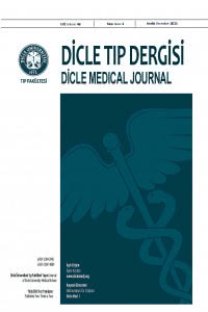Tip 1 Diyabetes Mellituslu Çocuklarda Tanı Anındaki Klinik ve Laboratuvar Bulgularının Değerlendirilmesi
Evaluation of Clinical and Laboratory Findings at the Time of Diagnosis in Children with Type 1 Diabetes Mellitus
___
- Atkinson, M. A. and G. S. Eisenbarth, Type 1 diabetes: new perspectives on disease pathogenesis and treatment. Lancet. 2001; 358: 221-29.
- Vurallı D, Kandemir N. Tip 1 diabetes mellitus. In: Cinaz P, Darendeliler F, Akıncı A, Özkan B, Dündar BN, Abacı A, Akçay T(eds). Çocuk Endokrinolojisi(4. Baskı). Pediatrik Endokrinolojisi ve Diyabet Derneği Yayınları, İstanbul: Nobel Tıp Kitapevleri, 2014; 399-452.
- Forouhi NG, Wareham NJ. Epidemiology of diabetes. Medicine (Abingdon). 2014; 42: 698-702.
- Handelsman Y, Bloomgarden ZT, Grunberger G, et al. American Association of Clinical Endocrinologists and American College of Endocrinology Clinical Practice Guidelines for Developing a Diabetes Mellitus Comprehensive Care Plan-2015. Endocr Pract. 2015; 21:1: 1-87.
- Wolfsdorf JI, Allgrove J, Craig ME, et l. ISPAD Clinical Practice Consensus Guidlines 2014.Diabetic ketoacidosis and hyperglycemic hyperosmolar state. Pediatric Diabetes. 2014; Suppl 20: 154-79.
- Ryan C, Vega A, Drash A. Cognitive deficits in adolescents who developed diabetes early in life. Pediatrics. 1985; 75: 921-7.
- Kandemir N, Açıkgöz E, Yordan N. The Epidemiology of Diabet Onset İnsulin Dependent Diabetes Mellitus in Turkish Children: A Retrospektive Analysis of 477 Cases. Turk J Pediatr. 1994; 36: 191-5.
- Hatun Ş, Teziç T. Ankara’daki Okul Çocuklarında Tip 1 Diabet Prevalansı. Çocuk Sağlığı ve Hastalıkları Dergisi. 1996; 39: 465-472.
- Gül A. Tip1 Diabetes Mellituslu Çocuk ve Adolesan Hastaların Retrospektif Olarak Değerlendirilmesi. S.B. İstanbul Bakırköy Kadın Doğum ve Çocuk Hastalıkları Eğitim Araştırma Hastanesi. Uzmanlık Tezi. İst. 2006.
- International Diabetes Federation. Diabetes Atlas. 6th edition, 2013. http://www.idf.org/diabetesatlas.
- Green A, Sjolie A.K, Eshoj O. Trends in the epidemiology of IDDM during 1970-2020 in Fyn County, Denmark. Diabetes Care. 1996; 19: 801-6.
- Güven A, Aydın M. Beş yaşından önce tip 1 diyabetes mellitus tanısı alan çocuklarda etiyopatogenezde rol alan faktörler. Çocuk Sağlığı ve Hastalıkları Dergisi. 2005; 48: 295-300.
- Taşkın E, Yılmaz E, Kılıç M, ve ark. İnsüline Bağımlı Diyabetes Mellitusun Epidemiyolojik Özellikleri. FÜ Sağ Bil Derg. 2007; 21: 75-9.
- Sağlam H, Eren E, Çakır ED, ve ark. Diyabetik ketoasidoz ile başvuran çocukların klinik ve labaratuvar özellikleri. Journual of Current Pediatrics. 2008; 6: 94-8.
- Şimşek E, Karabay M, Kocabay K. Batı karadeniz bölgesinde yaşayan çocuklarda insüline bağımlı diyabetes mellitusun epidemiyolojik özellikleri. Türk Pediatri Arşivi. 2003; 38: 216-22.
- Alemzadeh R, Wyatt DT. Diabetes Mellitus. In: Behrman RE, Kliegman RM, Jenson HB (eds). Nelson Textbook of Pediatrics. 17 edition. Pennsylvania: Elsevier Saunders; 2004. p.1947-72.
- ISPAD Clinical Practice Consensus Guidelines 2006- 2007. Assessment and monitoring of glycemic control in children and adolescents with diabetes. Pediatric Diabetes. 2007; 8: 408-18.
- Saka HN. Diabetes Mellitus. In: Günöz H, Öcal G, Yordam N, Kurtoğlu S (eds). Pediatrik Endokrinoloji (1.Baskı). Pediatrik Endokrinoloji ve Oksoloji Derneği Yayınları, Ankara: Kalkan Matbaacılık; 2003. p.415-55.
- Sperling MA. Diabetes mellitus. In: Sperling MA. (ed). Pediatric Endocrinology (2nd ed). Philadelphia: WB Saunders, 2002: p.323-63.
- Rosenbloom AL, Silverstein JH. Diabetes in the child and adolescent. In: Liftshitz F. (ed). Pediatric Endocrinology (4th ed). New york: Marcel-Dekker, 2004: p.611-51.
- Edge JA, Ford-Adams MA, Dunger DB. Causes of death in children with insulin dependent diabetes 1990-96. Arch Dis Child. 1999; 81: 318-23.
- Rosenbloom AL, Winter WE, Escobar O, Diabetes Mellitus. In: Lifshitz F, (ed.), Pediatric Endocr. 5th edition. New York: Informa Health Care 2007; 57-202.
- Lévy-Marchal C, Patterson CC, Gren A. Geographical variation of presentation at diagnosis of type 1 diabetes in children: The EURODIAB Study. Diabetologia. 2001; 44(Supp 3): 75-80.
- Neu A, Willasch A, Ehehalt S, et al. Ketoacidosis at onset of type 1 diabetes mellitus in children-frequency and clinical presentation. Pediatr Diabetes. 2003; 4: 77- 81.
- Jayashree M, Singhi S. Diabetic ketoacidosis: predictors of outcome in a pediatric intensive care unit of a developing country Pediatr Crit Care Med. 2004; 5: 427-33.
- Kocabaş A, Aldemir Kocabaş B, Karagüzel G, Akçurin S. Tip 1 diyabetes mellitus olgularımızın antropometrik ve metabolik izlem özelliklerinin değerlendirilmesi. Türkiye Çocuk Hastalıkları Dergisi 2013; 3: 113-118.
- Aydın H, Andıran N, Buluş D, Yağlı E. Tip 1 Diyabetes Mellituslu Hastaların Klinik, Laboratuvar, Sosyokültürel ve Demografik Özellikleri. Türkiye Çocuk Hast Dergisi 2016; 2: 112-9.
- Demiral M, Binay Ç, Şimşek E. Eskişehir ilinde tip 1 diyabetes mellitus tanısı ile izlenen hastaların epidemiyolojik özellikleri. Çocuk Sağlığı ve Hastalıkları Dergisi. 2016; 59: 14-20.
- Kong YH, Kim MS, Lee DY. Comparison of the prevalance of islet autoantibodies according to age disease duration in patients with type 1 diabetes mellitus. Ann Pediatr Endocrinol Metab. 2013; 18: 65- 70.
- ISSN: 1300-2945
- Yayın Aralığı: 4
- Başlangıç: 1963
- Yayıncı: Cahfer GÜLOĞLU
Yenidoğan sepsisinde tam kan sayımı parametrelerinin tanısal değeri
Nurten SERİNGEÇ AKKEÇECİ, Büşra SEĞMEN, SADIK YURTTUTAN, CAN ACIPAYAM, Zübeyde DİNÇER, GÖZEN ÖKSÜZ
Moleküler Hpv Uygulanan Olgularda Hpv Sonuçları ile Patolojik Materyallerin Karşılaştırılması
Anne Sütü ve Perinatal Faktörlerin Prematüre Retinopatisi Gelişimi Üzerindeki Etkileri
ONURSAL ÇETİN, FEYZULLAH TEMURTAŞ
Alpha-lipoic acid alleviates lipopolysaccharide-induced liver damage in rats via antioxidant effect
BEHZAT ÇİMEN, LEYLA ÇİMEN, İhsan ÇETİN, Aysun CETİNYUREK--YAVUZ
İdrar Yolu Enfeksiyonu Geçiren Diyabetli Hastalarda Siprofloksasin İyi Bir Seçenek Değildir
Nevzat GOZEL, Ayse Sagmak TARTAR, Emir DONDER, Kader UĞUR, Bedrettin ORHAN, İsa Ahmet BAL, Abdullah Mubin ÖZERCAN
İntraabdominal Apselerin Görüntüleme Eşliğinde Perkütan Drenajı
Çağrı DAMAR, Meltem ÖZDEMİR, Baki HEKİMOĞLU
Nezahat AKPOLAT, Narin GÜNDOĞUŞ, Kadri GÜL, Tuba DAL
Yenidoğanlarda Kardiyak Kateterizasyona İkincil ArteriyelTromboz
Ayşegül ZENCİROĞLU, Banu AYDIN, Sara EROL, Tamer YOLDAŞ, Hasibe Gokce CİNAR
Arterial Thrombosis Secondary to Cardiac Catheterization in Neonates
SARA EROL, BANU AYDIN, Hasibe Gökçe ÇINAR, Tamer YOLDAŞ, AYŞEGÜL ZENCİROĞLU
